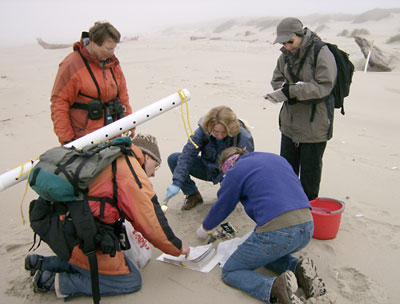BEACHED BIRDS
COASST beached bird participants conduct monthly surveys to systematically count and identify bird carcasses that wash ashore along ocean beaches from northern California to Alaska. As part of their involvement, participants learn about marine conservation and how to identify beached birds using the COASST Beached Birds field guide.
To get involved in our beached bird module:
- Sign-up and attend a 6-hour training session in your community. See our training calendar for upcoming events.
- Sign the COASST contract, agreeing to survey the beach of your choice every month.
- Submit a $20 refundable deposit for the Beached Birds field guide and survey toolkit.
- Grab a partner and head out to the beach to survey!
What's involved in a survey?
A COASST Beached Bird survey is definitely a commitment! Once you get to your beach, plan on 2-5 hours, with the total amount of time variable depending on the width of your beach, the length of your beach section (usually about 3/4 mile), the number of surveyors, the weather, and - of course - how many birds you find.
The entire beach area is searched for beached birds, from the surfline up to the live vegetation. For wide beaches, searching needs to happen on the way out (from start point to turnaround point) and also on the way back, to be sure to cover the entire width of the beach. You and your partner(s) will space yourselves out to cover as much ground as possible, and walk in a slow S-shaped pattern down the beach, looking right and left for beached birds.
Once found, documenting, identifying and photographing a bird might take 10 - 20 minutes, depending on how common/rare it is, how intact (or not) it is, and how experienced you are.
COASST records the total time you and your partner(s) spend surveying the beach to get accurate information on survey effort. Using this information, we calculate carcasses per person per hour and carcasses per kilometer, so it's important to do the survey all in one go, without stopping to do other things. Of course, short stops to watch a flock of shorebirds, marvel over a rainbow, or just take in the scenery is always encouraged!
It takes a team—especially on those outer coast beaches—to process all the birds.
